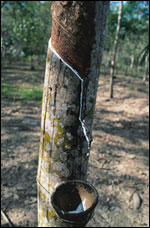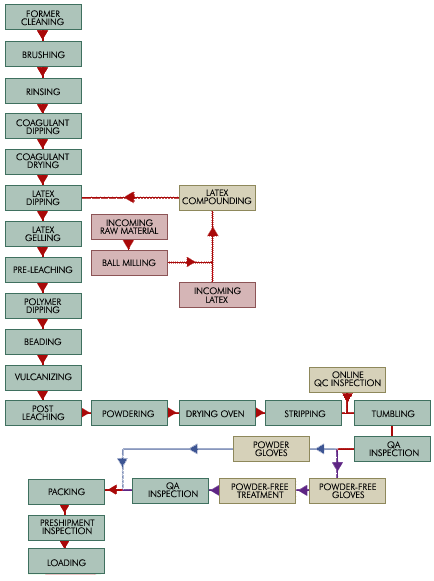
Continuing A Success In EducationAt DirectGlove, we do our best to educate everyone about choices, issues, developments and cost-cutting in the glove market place. We address the hazards, glove quality and safety issues. Our priority is the concern of the end users, customers, distributors and the reputation of their business.The History of Rubber
That same year, Sir Henry Wickham collected about seventy thousand rubber tree seeds in Brazil and took them to the East Indies where he started rubber plantations. In 1877, an American named Chapman Mitchell learned to recycle used rubber into new products. There is only one kind of natural rubber. Because the rubber plant only thrives in hot, damp regions near the equator, currently 90% of true rubber production occurs in the Southeast Asian countries of Malaysia, Thailand and Indonesia. Indonesia's production has dropped in recent years and new plantations were started in Africa to take up the slack. TopTapping of Latex RubberAll natural rubber originates in the Hevea tree. It starts its journey when the tree is tapped. It is very rare that trees are tapped twice a day. The journey begins at dawn when the tapper treks around the plantation. The tapper uses a sharp knife to shave off the thinnest from the intact section of the bark. The cut must not be made too thick or deep. This will reduce the productive life of the tree. On completion of his rounds of section tapping, the tapper returns and collects the stuff in the cup, either a cup lump or latex, which usually finishes at noon. In most circumstances, the latex will coagulates into a lump in the bottom of the cup. Ammonia is usually added to prevent the latex from coagulating.
To process solid rubber, the cup lump and other remains of the latex
flow are collected together and processed. It is heated intensely
and destroy most of the proteins and solid rubber is formed. Based
on certain method of processing and the final purity of the material,
it is usually referred as sheet rubber or technically specified rubber. Latex is gathered on the tapper's return journey and poured into
containers. They are then delivered to a processing station, where
is is strained and concentrated. At no process is the latex heated,
which means that the protein remains in the latex. More stabilizer is added and the latex goes into a centrifuge to remove some of the water and increase the rubber content of the latex. Latex concentrate is formed which contains about 60% of solid rubber and 40 % of water, proteins and other contents.. This latex concentrate is what used in the dipping process when making gloves. The Right Choice of Glove
Protection & Health Comfort & Fit Concerns on Allergy Studies have proven that if you contact Type IV Chemical Hypersensitivity, switching from latex gloves to non-latex gloves may not alleviate the situation. Chemicals are added in the process of manufacturing latex and non-latex gloves. Quality versus Cost Latex and vinyl gloves are generally very affordable. Nitrile gloves and other synthetic gloves are usually more costly. Types of GlovesLatex Examination Gloves Vinyl Examination Gloves Nitrile Examination Gloves Better stress relaxation for better comfort and less fatigue especially during long donning period. High resistance to a wide range of toxic chemicals and solvents, especially to hydrocarbons, oils and fats. High abrasion and puncture resistance. Very durable, excellent strength and flexibility. Good barrier properties. It is well noted for it's resistance to oil. It is less comfortable fit and less elastic than natural rubber. Nitrile gloves and other synthetic gloves are usually more costly. The Manufacturing Process
NotePlease be advised that all information referred in these pages are intended for educational purposes and knowledge all users our our existing products appropriate for protection defense against blood borne pathogens. All educational information and knowledge contained herein are based on technical information gathered we believed to be reliable. The educational material gathered maybe revised as additional data is analyzed and evaluated. DirectGlove / WholeSupply assumes no obligation and reliability resulting from use of these information, nor does it warranty the accuracy of the information as referred to herein. |
 Natural
rubber latex is a processed plant product derived almost exclusively
from trees found in Africa and Southeast Asia. Rubber was originated
from Brazil from the rubber tree, Hevea Brasiliensis. Brazil, no longer
plays any significant part in the world natural rubber (NR) trade.
Seeds were exported from Brazil to London in 1876 and germinated at
Kew Gardens.
Natural
rubber latex is a processed plant product derived almost exclusively
from trees found in Africa and Southeast Asia. Rubber was originated
from Brazil from the rubber tree, Hevea Brasiliensis. Brazil, no longer
plays any significant part in the world natural rubber (NR) trade.
Seeds were exported from Brazil to London in 1876 and germinated at
Kew Gardens.


 The
most important decision concerning healthcare workers, or professionals
in the medical and dental industry today is the right choice of glove.
When selecting examination gloves, we must always consider the following
below.
The
most important decision concerning healthcare workers, or professionals
in the medical and dental industry today is the right choice of glove.
When selecting examination gloves, we must always consider the following
below.